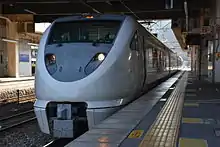Kinosaki (train)
The Kinosaki (きのさき) is a limited express train service operated by West Japan Railway Company (JR West). One of the services making up JR West's "Big X Network", it connects Kyoto Station and Kinosaki Onsen Station via the San-in Main Line. The color associated with the service is purple, also the line color of the Sagano Line which it uses for part of its journey.
 287 series EMU on a Kinosaki (4 cars) and Maizuru (3 cars) service, April 2011 | |
| Overview | |
|---|---|
| Service type | Limited express |
| First service | 1962 |
| Current operator(s) | JR West |
| Route | |
| Line(s) used | Sanin Main Line |
| Technical | |
| Rolling stock | 287 series, 289 series EMUs |
| Operating speed | 120 km/h (75 mph) |
Station stops
Kyoto - Nijō - Kameoka - Sonobe - Hiyoshi - Ayabe - Fukuchiyama - Wadayama - Yōka - Ebara - Toyooka - Kinosaki Onsen
- Some services stop at Hiyoshi Station.
Maximum operating speeds
- Kyoto – Fukuchiyama: 120 km/h (75 mph)
- Fukuchiyama – Kinosaki Onsen: 95 km/h (60 mph)
Rolling stock

- 287 series EMUs (since 12 March 2011)
- 289 series EMUs (from 31 October 2015)
Kinosaki services are operated with 287 series electric multiple unit (EMU) trains based at Fukuchiyama Depot. Some services operate as combined Kinosaki and Maizuru services. The 287 series EMUs were introduced on these services from 12 March 2011, replacing 183 series sets.[1]
289 series EMUs converted from former dual-voltage 683 series trainsets were introduced on Kinosaki services from 31 October 2015, replacing the remaining JNR-era 381 series trains.[2]
Former

- 183 series EMUs (until 15 March 2013)
- 381 series EMUs (from 1 June 2012 until 30 October 2015)
183 series EMUs were formerly used on some services, but were withdrawn by the start of the revised timetable on 16 March 2013.[3]
Fukuchiyama-based 381 series EMUs displaced from Kuroshio services were also introduced on Kinosaki services from 1 June 2012.[4] These were withdrawn following the final day of operations on 30 October 2015.[5]
History
The Kinosaki service is named after the service's terminus, formerly known only as Kinosaki Station. Also, when the service began, the neighborhood in which the station stood was known as Kinosaki. Both are derived from the region's well-known area of hot springs.
- March 1, 1962: the Kinosaki service begins as two daily round trips between Kyoto and Kinosaki.
- April 20, 1963: the Kinosaki running from Fukuchiyama Station is renamed to Tango. Daily service consists of four round trips per day.
- March 5, 1966: the Kinosaki and Tango become express services.
- November 10, 1968: Hakuto services departing Kyoto no longer connected with more cars at Ōsaka station. That service becomes the Daisen. The Kinosaki name is discontinued, and Tango services are increased to seven round trips daily. All Tango services are classified as express.
- December 1990: 183 series trains providing seasonal express service between Osaka and Kinosaki are once again called Kinosaki.
- 1995: seasonal express service ends. The following year, it is decided that permanent limited express Kinosaki service will be restored between Kyoto and Kinosaki.
- March 18, 2007: All cars become non-smoking.[6]
- March 16, 2013: From the start of the revised timetable, 183 series EMUs are withdrawn from Kinosaki services.[3]
References
- "新型特急新型電車287系導入へ (New 287 series limited express EMUs to be introduced)". Kyoto Shimbun (in Japanese). 2 October 2009. Retrieved 2 October 2009.
- JR西日本 289系 10月31日から運転開始 [JR West 289 series to enter service from 31 October]. Tetsudo Hobidas (in Japanese). Japan: Neko Publishing Co., Ltd. 21 August 2015. Retrieved 21 August 2015.
- "JR西日本の183系が定期運用を終了" [JR West 183 series withdrawn from scheduled services]. Japan Railfan Magazine Online (in Japanese). Japan: Koyusha Co., Ltd. 17 March 2013. Retrieved 17 March 2013.
- "JR西日本 381系福知山車FE編成が営業運転開始" [JR West: Fukichiyama-based 381 series FE sets enter service]. Tetsudō Daiya Jōhō Magazine. Vol. 41 no. 340. Japan: Kōtsū Shimbun. August 2012. p. 75.
- 381系が関西地区の定期運用から離脱 [381 series removed from scheduled Kansai area services]. Japan Railfan Magazine Online (in Japanese). Japan: Koyusha Co., Ltd. 31 October 2015. Retrieved 1 November 2015.
- JR電車編成表 2010夏 [JR EMU Formations - Summer 2010]. Japan: JRR. May 2010. p. 183. ISBN 978-4-330-14310-1.
External links
| Wikimedia Commons has media related to Kinosaki (train). |
- JR West 287 series Kinosaki (in Japanese)
- JR West 289 series Kinosaki (in Japanese)
.svg.png.webp)
